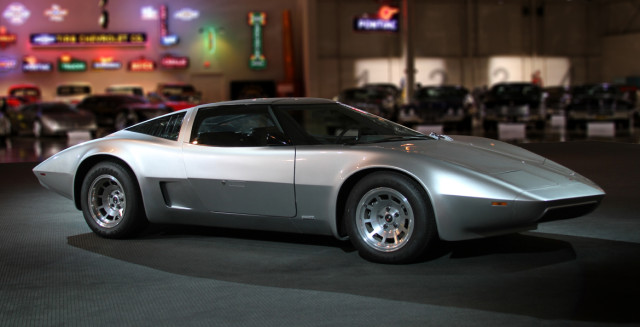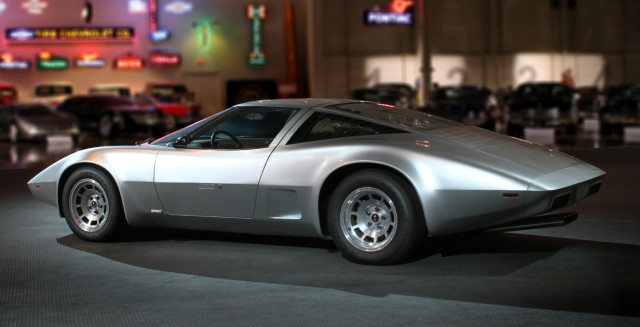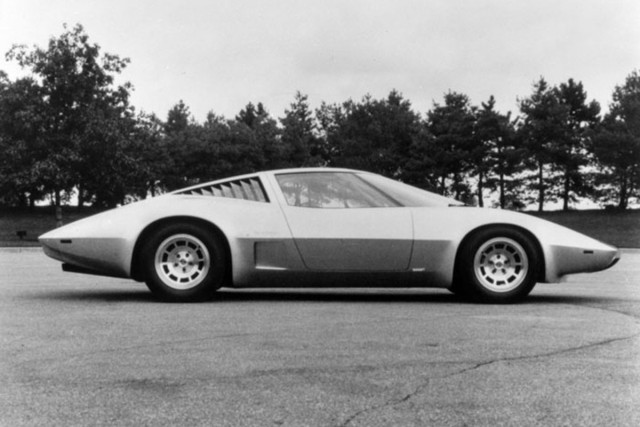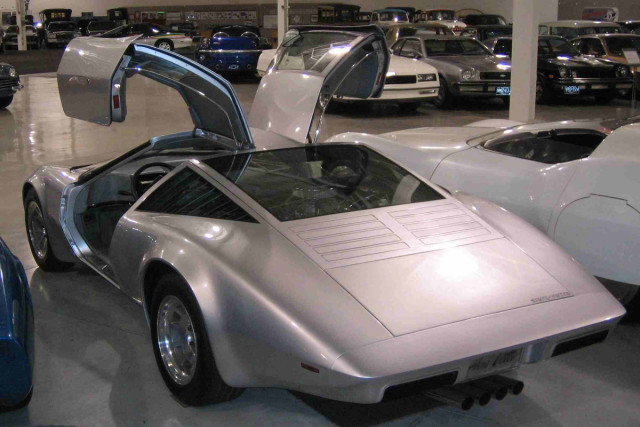
This mid-engine project started as XP-822. Eventually it was renamed the Aerovette, and was used to showcase GM’s newly-acquired rotary engine technology. Bill Mitchell’s design team gave the car a bold, aerodynamic shape, gullwing doors, and a window over the engine compartment to show off the then-installed experimental four-rotor engine. It was exhibited as the Four-Rotor Corvette with Sterling Silver paint and a silver leather interior. After GM abandoned its rotary engine program, Bill Mitchell gave the car new life by having the rotary engine replaced with a small-block V8. He then christened the car as the Aerovette. Images courtesy of GM Heritage Center.
by Randy Bolig as republished from Corvette Online
The Four-Rotor Corvette
Dateline November 2015: The concept car is an instrument used by automotive manufacturer’s to not only showcase ideas, but get the reaction of consumers about those ideas. These cars are never designed with a complete production likeness, but rather, to create a fervor about the possibilities.
Chevrolet has developed many concept cars over the years, and continues to do so. But for this Throwback Thursday, we want to focus on the car known as the Aerovette.
In 1969, Zora Arkus-Duntov and his team of engineers began creating two experimental cars called project XP-882. The XP-882 cars would be powered by mid-engine big-block 454 cubic-inch engines, and were built utilizing Oldsmobile Tornado drivetrain parts. The transmission was sitting in front of the engine, so a beveled-gear assembly was designed, and connected to a driveshaft that ran back through the oil pan to a conventional Corvette differential.
According to the GM Heritage Center, “Around the time the projects were close to being finished, John DeLorean became Chevrolet’s general manager and cancelled the program. He thought it too impractical, and too costly.” This decision to cancel the project was brief. When Ford announced plans to sell the Italian-built, mid-engine Pantera through Lincoln/Mercury dealers, DeLorean ordered one of the XP-882s be made ready for display at the 1970 New York Auto Show.

The Pantera announcement could not go unanswered by General Motors. After the completion of the show, XP-882 was again placed in storage, and almost forgotten.

In late 1971, the XP-882 project was readied for the 1972 Auto Salon in Paris, France. At this time, GM was spending a lot of money licensing and developing its own version of the rotary engine. The General’s rotary-engine design was to feature twin rotors, and was initially intended to power the compact Vega. Ed Cole, then President of General Motors, was impressed with the rotary engine concept, so the V8 engine in the car was removed, and in its place went a newly-designed, General Motors four-rotor engine. This engine was built by merging two of the two-rotor units designed for the Vega. This is how the car became known as the Four-Rotor Corvette.
Innovative features like gullwing doors, a V-shaped front windshield, plastic bumpers, pop-up headlamps, an independent rear suspension, and four-wheel disc brakes were also incorporated into the design.
Inside was a digital gauge panel, and a switchable screen that could show fuel, water temperature, oil pressure, or voltage. There was also a second digital display in the center console to show the date, time, radio stations, as well as the elapsed time in minutes and/or seconds for use at timed events.
In 1976, the four-rotor engine was replaced by a 400 cubic-inch small-block engine, and the concept car was named Aerovette. Unconfirmed reports say it was allegedly slated for production as a 1980 model, and the production car was to use a 350 cubic-inch V8, and carry a price tag between $15,000 and $18,000. However, after Duntov, Bill Mitchell, and Ed Cole retired from General Motors, management decided that a traditional Corvette was more economical to build, and canceled the Aerovette program. That being said, a source at GM says, “There was a design referred to internally as the 1980 Corvette that was an evolution of the Aerovette, which never saw the light of day.”

According to the GM Heritage Center, Bill Mitchell, then Vice President of Design, lobbied for the Aerovette as the next Corvette, and GM chairman and CEO, Thomas Murphy actually approved the Aerovette for 1980 production. In the end, management decided that they were selling every fiberglass-bodied, front engine V8 “traditional” Corvette they could build, so why make a huge, risky investment in a mid-engine car. The Aerovette project was cancelled, and the Aerovette is now part of the GM collection at the Heritage Center.
Finally, in case you’re wondering what happened to the other XP-882 chassis, it became what is referred to as the Reynold’s Aluminum car.
So what do you think, should a mid-engine Corvette hit showrooms?
